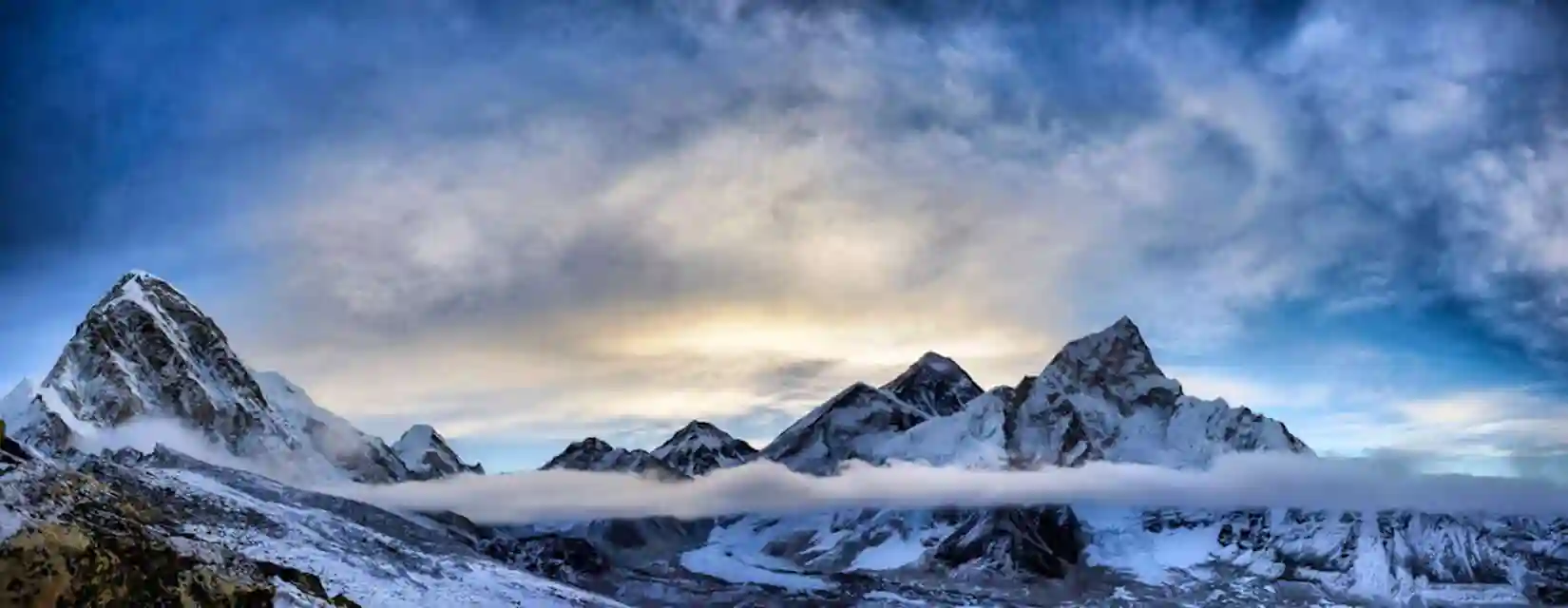Imagine setting foot into a world where the air is crisp, the mountains tower above in regal splendor, and every path leads to a new breathtaking vista. This isn’t just a dream; this is a reality waiting to happen at the core of Nepal. Trekking through the less traveled paths of the Himalayas gets one out of the monotony and into an escapade into the soul of the mountains. Be a seasoned trekker or a curious adventurer, less traveled trails of Nepal beckon with promises of untouched beauty and unmatched serenity.
Find the Magic: Everest’s Less Popular Trails
A Stage over Renjo La, Cho La, and Kongma La
The Everest Three High Pass Trek is less about arriving at Everest Base Camp than about making the journey across wild and untamed landscapes few people dare to tread. Renjo La Pass presents you with panoramic views that seemingly go well beyond the horizon, and leave any visitor gasping-not out of altitude, but due to beauty. The Cho La Pass, with icy trails and towering glaciers, demands resilience and rewards it with an up-close encounter with the might of the Himalayas. Kongma La, the final challenge, is not just a pass-it’s a gateway to the most spiritual villages nestled in the mountains where the Sherpa culture comes alive in all its richness.

Physical Preparation for this Majestic yet Grueling Journey
But to defeat such mighty passes, one needs to get ready. The more your mind is prepared, the more your body should be prepared, and all that begins with some great cardio training. Imagine doing runs on steep inclines, cycling on rugged terrains, or climbing endless stairs-things which, with every step, get you closer to being trek-ready. It is not all about endurance; strength then becomes your second ally. Squats, lunges, and calf raises will keep your legs prepared for those really tough days. And of course, your core will be stabilized with planks and leg raises to steady every move you make. While the strength and endurance are important, flexibility through yoga or stretching sessions each day will keep your body limber, reducing any risk of injury. Couple that with watching your diet, hydration, and sleep, and you become pretty much unstoppable.
Mental Wherewithal: The Unseen Strength Behind Each Step
Himalaya trekking is not only physically demanding-it’s a battle in the mind. To be well prepared, it is necessary for you to fully understand the routes for Renjo La, Kongma La, and Cho La. Study them, create a vision of them, and build appropriate expectations of what is to be encountered: simplistic shelters, plain food, and comforts at a minimum. So important is it that the concept be surrendered to the simplicity of nature and to appreciate the journey. Mindfulness and meditation in the mental preparation will see you through, even when things get really tough. Every high-altitude challenge, every insurmountable obstacle, offers a chance for growth, to prove to yourself that you are capable of more than you ever imagined.

Rising Above: Conquering Altitude and Embracing the Wild
Altitude Acclimatization: The Lifesaving Practice
Acclimatization is your lifeline in the Himalayas. The higher you ascend, the thinner the air becomes, and the higher the requirement for time consumed by your body to adjust. Before embarking on the trek, acclimatize your body to high-altitude hiking. Allow yourself to feel and learn how to cope with the symptoms of AMS. Understand the early symptoms of AMS and how to prevent them. Each thoughtfully and slowly taken step will go a long way. The difference between a successful trek and a dangerous situation is always in the preventative measures of high-altitude training and AMS education.
Gear Essentials: Equipping Yourself for Success
When it comes to the craggy passes, your gear is your best friend during the trek. Start with your essentials: base layers, insulating layers, and waterproofs are absolute must-haves. Protect your extremities with gloves and hats; make sure your trekking boots will match up to the task. Extra-innovative people might want to bring crampons, ice axe, harnesses, among other optional equipment. Try out your gear in Kathmandu or rent good ones out so that you are better equipped to take whatever nature has in store for you. Your trek isn’t about walking; it’s about walking prepared.
How to Work Out the Bureaucracy: Permits and Paperworks
Right before stepping onto those trails, you are going to have to get the proper permits. You will be obliged to obtain both the Sagarmatha National Park permit and the Khumbu Pasang Lhamu Rural Municipality permit. Of course, you also want to remember your passport, visa, and travel insurance, along with some passport-sized photos-mandatory documents which might save you from a lot of hassle later on. Getting these in order well in advance of your trek leaves you free to focus on the adventure ahead.

Best Season to Go Trekking: A Decision That Calls for Wisdom
Timing, very much like the terrain, plays an important factor in the Himalayas. Each season presents one with unique challenges, from the monsoon rains that turn trails into raging rivers to winter snowfalls that turn paths into icy barriers. Prepare yourself: seasonal gear including rain jackets, insect repellent, and proper climbing equipment. Success in a trek depends a lot on knowing when to go and what to bring.
Conclusion: Ready to Start the Himalayan Venture?
You know it all, you are prepared for it, and you have the spirit-now it is the time to put everything into action. The hidden trails of Nepal are calling you-an experience that will not only put your limits into the test but give a new meaning to the very word. Be it the quiet wide valleys or towering passes, each stride will take you deeper into the world and within your soul in a way you have never done before. Lace up your boots, and remember—this is not just a trek but an induction into the Himalayas.

